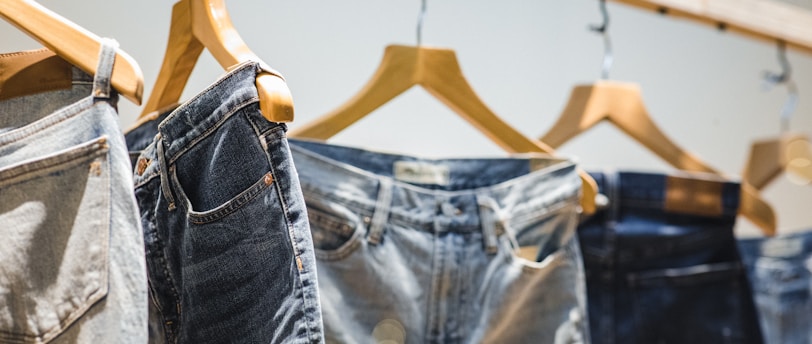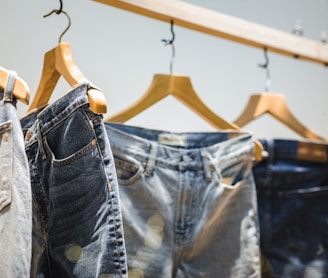Jeans Manufacturing Guide: From Design to Production
Jeans Manufacturing Guide: From Design to Production If you're thinking about starting a denim fashion brand, it's essential to understand the basics of jeans manufacturing. From the design process to the final product, this guide will provide you with everything you need to know about jeans manufacturing.
GARMENTS MANUFACTURING GUIDE


Jeans are an essential part of our everyday lives, and denim fashion brands are a lucrative business. However, creating high-quality denim products requires a deep understanding of the manufacturing process. In this guide, we'll walk you through the essential steps of jeans manufacturing, from design to production, so you can create your own denim fashion line.
The Design Process
The design process is the foundation of any fashion brand, and it's no different for denim products. The following are the critical steps in the design process:
Sketching and Conceptualizing
The first step in designing your jeans is to come up with a concept. Sketching is an essential part of the design process, as it allows you to put your ideas on paper. Use the sketches to refine your concept until you have a clear vision of what you want your jeans to look like.
Technical Drawings
Once you have your concept, the next step is to create technical drawings. Technical drawings are precise, to-scale illustrations that show every aspect of your design. These drawings are used to communicate with the pattern makers and sample makers.
Pattern Making
After creating the technical drawings, the pattern maker will make a pattern. The pattern is a blueprint for the jeans, and it shows how the fabric pieces should be cut and sewn together.
Grading
Once the pattern is created, it's graded. Grading is the process of creating different sizes of the same pattern. Grading ensures that your jeans fit people of all sizes.
Sampling
Once the pattern is graded, a sample is made. Samples are used to ensure that the jeans look and fit the way you want them to.
Fabric Selection
Choosing the right fabric is crucial in jeans manufacturing. The following are the essential factors to consider when selecting denim fabric:
Types of Denim Fabric
There are several types of denim fabric, including raw, selvedge, and stretch denim. Each type has its unique characteristics, so it's essential to choose the right type for your design.
Denim Fabric Quality
The quality of the denim fabric you choose will affect the overall quality of your jeans. High-quality denim will last longer and look better than lower quality denim.
Sourcing Fabric
Finding the right fabric supplier is crucial in jeans manufacturing. Look for suppliers that offer high-quality denim fabric and have a good reputation in the industry.
Pre-Production
Pre-production is the stage where the fabric is cut, sewn together, and adjusted to ensure a good fit. The following are the essential steps in pre-production:
Cutting the Fabric
The first step in pre-production is cutting the fabric. The pattern is used as a guide to cut the denim fabric into the correct shapes and sizes.
Sewing the Pieces Together
After the fabric is cut, the pieces are sewn together. The sewing process requires skill and precision to ensure that the pieces are aligned correctly and sewn together neatly.
Fitting and Adjustment
Once the jeans are sewn together, they're fitted on a model or a mannequin to ensure a good fit. Any necessary adjustments are made at this stage to ensure that the final product looks and fits the way you want it to.
Production
Production is the stage where the jeans are mass-produced. The following are the essential steps in production:
Mass Production
Once the sample is approved, the jeans are mass-produced. This involves cutting and sewing together multiple pairs of jeans using the same pattern.
Quality Control
Quality control is crucial in the production stage. Every pair of jeans is inspected to ensure that they meet the required standards of quality. Any defective pairs are removed from the production line.
Finishing
Finishing is the final stage of jeans manufacturing, where the jeans are washed, distressed, and labeled. The following are the essential steps in finishing:
Washing and Dyeing
The first step in finishing is washing and dyeing. This process gives the jeans their final color and texture. Different washing and dyeing techniques can create different looks, such as faded or vintage-style jeans.
Distressing and Sanding
Distressing and sanding are techniques used to create the worn, vintage look that many denim lovers prefer. These techniques involve using tools to create small tears, holes, and worn patches in the fabric.
Labeling and Packaging
Once the jeans are finished, they're labeled and packaged for sale. The labeling includes the brand name, size, and care instructions. Packaging is also an important factor in the presentation of the final product.
Marketing and Sales
Marketing and sales are crucial in the success of a denim fashion brand. Social media, influencer marketing, and online sales platforms are just a few ways to reach your target audience and increase sales.
Conclusion
Jeans manufacturing requires a deep understanding of the design process, fabric selection, pre-production, production, and finishing. By following the steps outlined in this guide, you can create high-quality denim products that are both stylish and durable.
FAQs
What types of denim fabric are there?
Raw, selvedge, and stretch denim are just a few types of denim fabric.
What is grading in jeans manufacturing?
Grading is the process of creating different sizes of the same pattern to ensure that the jeans fit people of all sizes.
What is pre-production in jeans manufacturing?
Pre-production is the stage where the fabric is cut, sewn together, and adjusted to ensure a good fit.
What is the finishing stage in jeans manufacturing?
Finishing is the final stage where the jeans are washed, distressed, labeled, and packaged for sale.
How important is marketing and sales in denim fashion brands?
Marketing and sales are crucial in the success of a denim fashion brand, as they help reach the target audience and increase sales.
